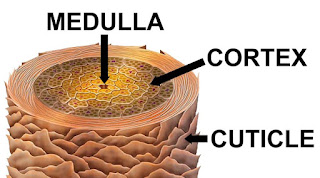This is a quick follow-up to my previous post. I decided to split it to prevent an over- lengthy post. The Andre Walker system might be well recognized but is not the only system used to determine curl patterns.
FIA HAIR SYSTEM
This is a method that is classified by curl pattern, hair strand thickness and overall hair volume.
CURLINESS
Straight
- 1A - Straight- stick.
- 1B - Straight but slight body wave adding some volume.
- 1C - Straight with body waves and one or two visible S- waves.
Wavy
- 2A - Loose with stretched S- waves throughout.
- 2B - Shorter with distinct S- waves.
- 2C - Distinct S- waves, some spiral curling.
Curly
- 3A - Big loose spiral curls.
- 3B - Bouncy ringlets.
- 3C - Tight corkscrews
Very (really) Curly
- 4A - Tightly coiled S- curls
- 4B - Z- patterned (tightly coiled, sharply angled).
- 4C - Mostly Z- patterned (tightly kink, less definition.
STRANDS
Fine
Thin strands that sometimes are almost translucent when held up in the light. Shed strands are hard to see against a constrasting background. It feels like ultra- fine strand of silk.
Medium
Strands are neither fine nor coarse. It feels like rough cotton thread. It is not stiff or rough.
Coarse
Thick strands which can easily be identified against any background. It feels hard and wiry, and may hear it if you roll it between your fingers.
VOLUME
VOLUME
Volume by circumference of a full hair ponytail.
Thin- Circumferences less than 2 inches (5 centimeteres).
Normal - From 2 to 4 inches (5-10 centimetres).
Thick - More than 4 inches (10 centimetres).
LOIS HAIR SYSTEM
This system compares hair strands to the letters L, O, I, S. Take a strand and compare it to the shapes if the letters.
CURL PATTERN
The bends, kinks and coils will or may resemble more than one of the letters.
- L - The strand will look like the letter L with right angles, bends and folds.
- O - Your strand resembles the letter O or spirals into several Os.
- I - The strand is straight with little or no curves or waves .
- S - Your strand is wavy and curves back and forth like the letter S.
- Combination - Your strand may have a combination of two or more letters. If this is the case, then check a few more strands all over your head to know which of the letters is more dominant.
- A strand of frayed thread is about the same size of a medium sized strand of human hair. If your strand is larger than it, then, your hair is thick. But if it is smaller than it, then your hair is thin or fine.
TEXTURE
Shine is a sharp reflection of light while sheen is a dull reflection of light.
- Thready - Hair has a low sheen with high shine if the hair is put in a braid with little frizz. Wets easily but dries out quickly.
- Wiry - It has a sparkly sheen with low shine and low frizz. Water beads up or bounces off the hair strands. It never seems to get fully wet.
- Cottony - It has low sheen, high shine if it is held together with high frizz. Absorbs water quickly but does not get thoroughly wet very fast.
- Spongy - Hair has high sheen with low shine with compacted looking frizz. Absorbs water before it gets thoroughly wet.
- Silky - Hair has low sheen, a very high shine with a lot of low frizz. Easily gets wet in water.
Personally, I do not consider hair typing as necessary in terms of hair care. Though I have heard of some ladies using it as a guide to creating a hair regimen. Do note that even if you are a 4C or 3C as the next lady, it does not necessary mean that what works for her will work for you because every individual is different.
Do tell me which if these hair typing systems you prefer or which you can easily relate with.








